-
How to Measure for a New Garage Door
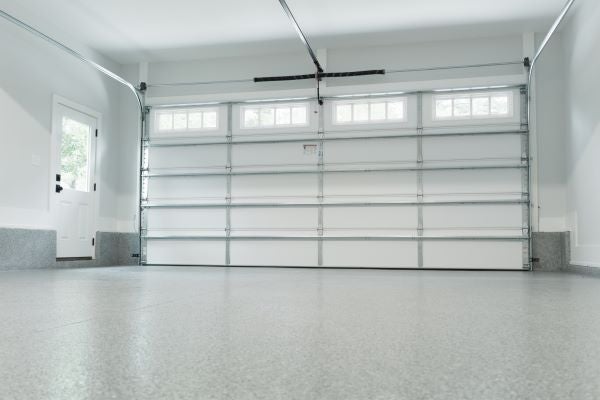
How to Take Accurate Measurements for a New Garage Door
Your choice of garage door will be greatly influenced by the specifications of your garage opening. This information focuses on the tools you’ll need to measure your garage in order to pick the right garage door in Pittsburgh, PA.
In order to measure your garage door, you’ll need the following items:
Measuring tape
Step ladder
Paper and pen
After gathering the required materials, follow these steps to accurately measure your garage door.
Step 1 – Height and Width
The first step is to determine the height and width of the door space. Make sure that you are measuring the width of the garage door area at its widest point. Measure the opening from top to bottom. Take note of the highest point of the area as well.
Step 2 – Side Room
Measure the areas next to the door openings if you are installing vertical tracks. If you have a specific design in mind, research what the installer or manual specifies to make sure the door will work in the area you have available.
Step 3 – Headroom
In this step, measure the headroom of the garage door to get a complete estimate for the total size of the garage door. With a step ladder, calculate the distance from the door opening to the ceiling.
Step 4 – Backroom
The final step is measuring the backroom, or in other words, the depth of your garage. Again, a professional installer of your garage door will give you the required measurements for the door’s backroom.
Other Considerations
There are specific factors to keep in mind when measuring a new garage door. For example, if you are using a door opener, you will need to find or install a new electrical outlet. Staircases and lights around the garage should be taken into account while installing the door or the opener.
Additionally, inspect the headers and jambs to make sure that they are stable and in proper working order. Take note of the ductwork, any pipes, and wires that may interfere with the operation of your new garage door. If you are replacing an existing door, compare the old door with the new one.
Contact our team at Thomas V. Giel Garage Doors, Inc. for all of your garage door needs.
-
3 Tips for Choosing the Right Storm Door for Your Home
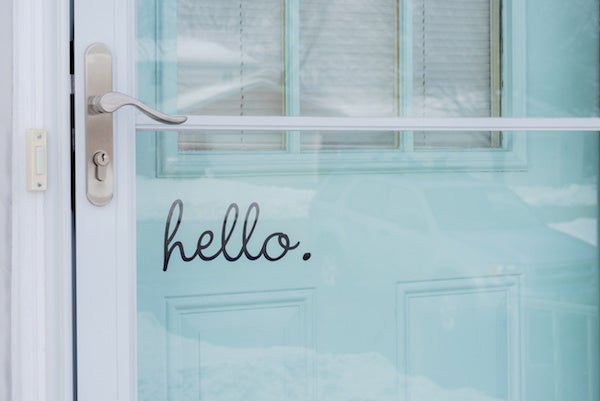
Homeowners often look for projects to make an area more appealing or practical. A storm door can add beauty and energy efficiency to a home. Given the variety of storm doors on the market, finding the right one can require some research and deliberation. We’ve outlined some ideas for storm door selection to assist you in the decision making process. Check out these tips for choosing the right storm door for your home.
Storm Doors for Hot and Cold Weather
Glass panels in a storm door allow light and warmth to pass through, illuminating either the home or the second door. The heat from a glass door can be quite welcome in the winter, but the opposite may be true during the summer months. Heat may get trapped between the glass door and the entry door, causing the entry door to warp. Screens, on the other hand, allow heat to transfer freely between the outside and inside, which is more agreeable in warmer weather.
Determine How Much Security You Need
A storm door can serve many functions. It can enhance the home’s appearance, allow sunshine and fresh air to enter the home, and provide added security. For people who desire extra protection against break-ins, a storm door with a high-end lock system may be a viable option. Some storm doors feature metal grilles or shatter resistant glass which will help deter any unwelcome visitors.
Find the Right View
Some storm doors allow maximum visibility because they are made of glass from top to bottom. Others offer a view through the top half of the door only. A full glass panel allows a great deal of heat and light to pass through, so homeowners often choose doors with built-in blinds. Partial panels have a smaller surface area than full panels, so they are less likely to be broken by a stray ball or other object. A partial panel offers less visibility than a full panel does, but some owners prefer this type of storm door because replacement glass is more budget-friendly.
Storm doors are welcome additions to most homes. Adding or replacing a storm door requires sifting through countless options of materials and styles. Although there are plenty of factors to consider, we have listed some of the primary determinants in figuring out which type of storm door will work best for your home entry. Call Thomas V. Giel Garage Doors, Inc. today for complete details on all entry, storm, and patio doors. For more helpful information about improving your home, browse the Thomas V. Giel Garage Doors, Inc. blog.
-
3 Reasons to Install a Retractable Pergola This Spring
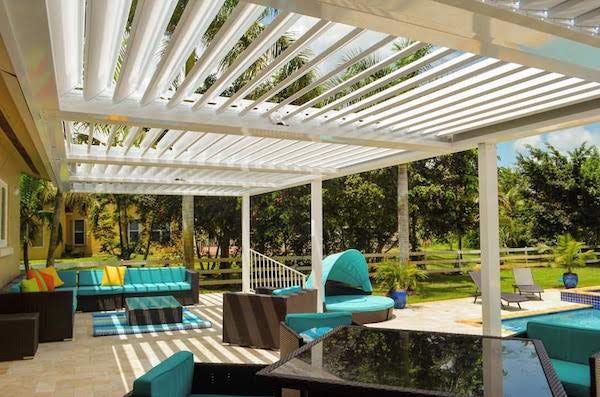
For many Americans, spring represents the onset of home and yard improvements. Countless products and projects promise a more beautiful or functional area. Neighbors share ideas and sometimes compete to have the newest or most beautiful pieces. Savvy homeowners often instigate projects that will improve both beauty and functionality. Among such projects are shade structures such as gazebos and pergolas. Different varieties of these structures offer varying benefits. Below are a few reasons to install a retractable pergola this spring.
Protect Skin and Belongings
Sunshine is a welcome aspect of spring weather. Prolonged exposure to sunlight can damage skin, fabric, and other articles. Nature lovers express growing concern over skin cancer, dark spots, and other sun-related ailments. A retractable pergola provides relief from harmful ultraviolet rays. It also serves to protect an area from falling debris, and the shade created by a pergola offers relief from summer heat.
Save Energy
When outside temperatures rise, a home will require additional air conditioning to maintain a comfortable living space. A pergola or other shade structure can reduce the amount of direct sunlight a home receives. Because direct sunlight heats a home’s interior, reducing rays can help keep a home cool, lowering energy usage and cost. The shade will likewise reduce the temperature of the covered outdoor area. If the exterior temperature is cooler, especially around doors and windows, the home will be cooler as well.
Enhance Your Home
Few projects can enhance a home as much as installing a retractable pergola. The home will be more aesthetically pleasing, and occupants will delight in a comfortable outdoor space. Increased comfort outdoors often translates into a more enjoyable home atmosphere altogether. Additionally, a retractable pergola improves a home’s resale value, so homeowners can experience additional security when the time comes to appraise or sell their home.
Human nature leads us to continually seek ways to improve ourselves and our surroundings. Spring is an excellent time to improve a living space. Although many remodeling projects are available, retractable pergolas are an increasingly popular option for homeowners nationwide. If you are looking to protect yourself and your belongings, save energy, and enhance your home, a retractable pergola from Thomas V. Giel Garage Doors, Inc. may be the best choice for you this spring. For more helpful information about home improvements, browse the Thomas V. Giel Garage Doors, Inc. blog.
-
How to Make the Most of Your Garage Transformation

As families are spending more time inside their homes, the need for space is becoming increasingly apparent. Homeowners explore new techniques for maximizing and optimizing their space. Many families consider home expansion or other major changes to available living space. Garage transformation is a common candidate for home improvement projects. If you are looking into this type of remodel, the following strategies can help determine what specific project and what methods will be the best fit for your garage transformation.
Create Working Space
Many businesses offer work-from-home options. Employment from home demands some degree of privacy and space, so a home office may be a welcome improvement on an existing residence. Hobbies and home-based businesses can be aided by the creation of additional room. A new craft room or study can increase productivity as well as improving mental and emotional health.
Build an Additional Recreational Area
There are a number of home-based activities families and individuals have adopted during their free time. Multiple interests within the same household may lead to scheduling or personal conflicts, and the addition of a home theater or toy room can promote goodwill within a family while providing opportunities for individual pursuits.
Improve Living Space
A home’s value can be dramatically augmented by an additional bedroom, bathroom, or other living area. If there is no current need for a bed/bath combo, such an improvement can be rented out for additional income or can be utilized as living quarters for relatives who are aging or otherwise afflicted. Providing additional living space for children, snoring spouses, or tenants can provide immediate benefits as well as long-term return on investment.
Converting a garage into indoor space is an increasingly popular home improvement project. The prospect of additional usable space appeals to many homeowners. For individuals who are considering instigating a garage transformation, special considerations should be made before taking on a project. First decide what end result best suits your needs, then begin the planning process. Think about the points above when preparing for a garage transformation project. For more helpful tips for getting the most out of your garage, browse the Thomas V. Giel Garage Doors, Inc. blog.
-
4 Steps for When Your Garage Door Gets Stuck
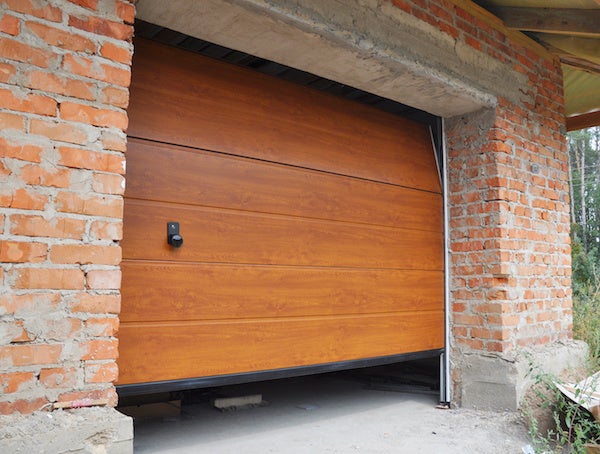
When a garage door gets stuck, it creates a major annoyance as well as a safety hazard. Homeowners ought to be able to open and close the door whenever they please. On occasion, however, the garage door simply won’t cooperate. Here are some steps you can take when your garage door gets stuck.
Confirm Power
A lack of power is typically the easiest issue to fix, so start there. Ensure the garage door opener is plugged into an outlet. If it is, test the outlet by plugging in another device (such as a nightlight) and seeing whether or not the new device is receiving power. If the car remote or keypad will not open the door but the interior button will, try a new set of batteries in either the remote or keypad as needed.
Check the Lock
The locking feature may have been inadvertently activated. Check the interior panel to make sure it is not “locked.” In lock mode, the door will not respond to remotes. The interior button will usually be lit to some degree. A steady light indicates that the door is unlocked while a flashing light usually means the door is locked. To lock or unlock a door, press and hold the “lock” button until the light pattern changes.
Lubricate Moving Metal Parts
Most hardware stores sell lubricants designed specifically for garage door openers. Use this type or another silicone-based lubricant. Spray a small amount of lubricant on top of the rails, at metal hinges, and along metal springs. During this step, also ensure bolts and other fasteners are secure. Lubrication is an important step in door maintenance and should be performed at least once every six months.
Test the Alignment
When a garage door becomes misaligned,it often struggles to open or close. If the door is stuck, try using the manual release to slide the door open or closed by hand. When properly lubricated, the door should glide easily and smoothly. If not, the door is likely misaligned, which will require professional attention.
Some home maintenance concerns can be handled without professional help. In the event of a garage door getting stuck, several steps can be taken at home before reaching out to a professional repair team. Follow these steps to diagnose and remedy the stuck garage door.
If your garage door is causing your problems, schedule a service call with Thomas V. Giel Garage Doors, Inc. experts. For more helpful information about maintaining your garage door, browse the Thomas V. Giel Garage Doors, Inc. blog.
-
How to Prevent Garage Fires
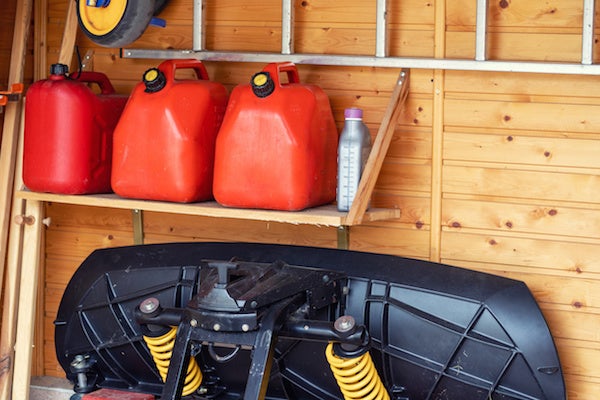
Owners and renters invest a great amount of time and money to prevent or minimize fire damage. Local building codes set a number of standards to reduce fire hazards. Fires can spread quite rapidly from one area to another, including the garage. Within the home, we take several precautions, and we should do so in the garage as well. Here are some tips on how to prevent garage fires.
Take Care of Your Chargers
Many individuals store power tools or other electronics in the garage. If a charger or other device is plugged into a garage outlet, take care to reduce the associated risk of fire. Since electronics emit warmth, allow plenty of space between devices. This will prevent too much heat from building up. Ensure that each device has adequate airflow to its ventilation fan. Proper ventilation will also reduce the risk of fire.
Store Flammables Responsibly
A garage can be home to a number of highly-flammable materials, including gasoline, kerosene, turpentine, and more. Store such items in a fireproof metal cabinet. Make sure that the cabinet door closes securely. By securing the flammables apart from other garage items, you will significantly reduce the amount of fuel for any potential fires. In the event of a fire, the closed metal door can minimize the temperature within the cabinet.
Eliminate Clutter
Garages are commonly intended for storing outdoor items such as garden tools, snow blowers, and bicycles. Over time, many unplanned items take up residence in the garage. Experts recommend that occupants maintain the garage at a “home-like” level of clutter. Each item is flammable to some degree, so clutter removal is one of the most effective ways to reduce the risk of fire.
Each year, Americans spend billions of dollars on home fire insurance and fire prevention methods. A number of house fires begin in the garage. The garage is usually attached to or close to the home, so it is important to prevent fires in the garage as well as the home. By limiting the potential fire hazards as listed above, an owner or renter can help prevent garage fires. For more helpful information about keeping your home safe and secure, browse the Thomas V. Giel Garage Doors, Inc. blog.
-
Common Winter Door Problems and How to Fix Them
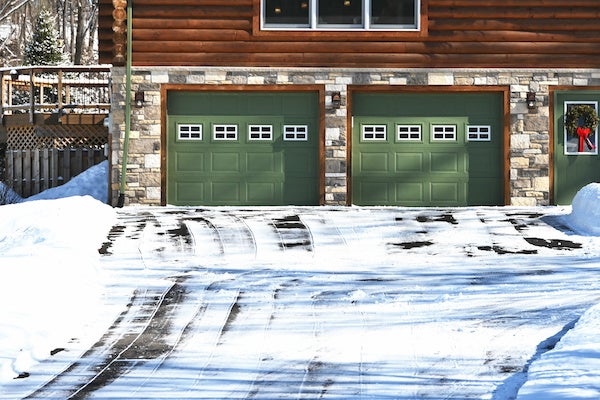
For people living in colder climates, winter can be harsh and destructive. Icy winters can produce a number of troubles. Car batteries are strained, walkways become slippery, and garage doors can start having problems. Many of these issues can be resolved without enlisting a professional. Check out these common winter door problems and how to fix them.
Ineffective Lubricant
In warm temperatures, lubricants are more runny and can move around easily. During the winter, lubricants become more dense, and heavy grease may not move easily enough to properly lubricate the garage door opener. Lubrication reduces the amount of work a motor must perform in order to open the garage door. If a heavy grease has been used, apply an even coat of a silicone-based lubricant. A local hardware store will most likely carry a product designed specifically for garage doors.
Frozen Garage Door
During periods of prolonged freezing, garage doors may become frozen and refuse to budge. Frozen garage doors are highly inconvenient, and they can cause further damage to the garage door opener. An immobile door strains the motor, and pieces of the door itself can break if the door is forced open. Where the door meets the ground, remove any existing ice with hot water and a snow shovel. Once the area is clear and dry-ish, apply ice melt as needed. Regular snow removal can prevent future icing.
Fatigued Metal Parts
Metal parts (such as springs) often face additional strain during winter months. More force is often required to open the door in the cold, due to less lubrication and other issues. The increased work can advance a metal part from being strained to outright fatigued. Cold temperatures often render moving parts brittle, and more likely to snap. To avoid potential damages, replace worn parts before they have a chance to break.
Winter can be a festive time for visits and winter sports. The cold season, however, is a time when extra precautions must be taken. Preventative measures can improve the lifespan of the door opener while preventing lockouts. If you run into any of these common garage door problems this winter, the solution may be rather simple.
If your garage door is causing your problems, schedule a service call with Thomas V. Giel Garage Doors, Inc. experts. For more helpful information about maintaining your garage door, browse the Thomas V. Giel Garage Doors, Inc. blog.
-
How to Make Your Garage Door More Secure
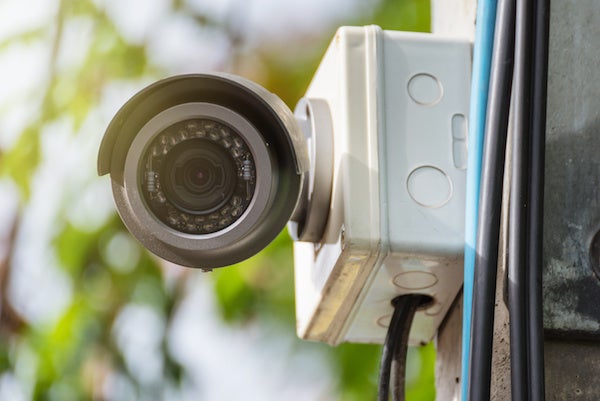
Home security is a top priority for homeowners and renters alike. Each year, Americans spend billions of dollars on home security systems. Doors and windows can be secured by locks and even iron bars, but homeowners often puzzle over what to do with the garage. Below are some tips for making your garage door more secure.
Lock Doors
It may seem like a given, but many homeowners (and renters) do not possess garage door locks. These simple devices can be purchased for around $10 and are relatively easy to install. Like other types of locks, a garage door lock requires a key for entry. For additional security, lock the door between the garage and the home. This simple task can further deter anyone who managed to gain entry to the garage.
Frost Windows
Garage windows serve to let in natural light as well as adding a little style to any structure. Clear garage windows, however, cannot prevent peeping eyes from discovering what treasures lie within. Homes are less likely to be targeted if belongings are easy to view. Keep your items hidden (more or less) by frosting the windows in the garage and garage door.
Motion-Detecting Lights
Would-be burglars go to great lengths to remain unseen. A motion-detecting light can help thwart criminal activity in two ways. First, it illuminates the area so that their activity can be seen more easily. Second, and perhaps more importantly, when an exterior light is turned on, it sends a message along the lines of, “I see you.” Criminals often walk away if they think someone is watching them. Install a motion-sensitive flood light over any area that could use added security.
Monitor Activity
Home surveillance can include much more than a video recording. Many systems are viewable remotely, meaning that a garage door can be monitored from the office or vacation destination. Most of these will notify you when movement is detected. Some systems have microphones and speakers, allowing the residents to communicate with visitors.
Garages provide a way for residents to both store a vehicle and access the home. While a garage door is highly convenient for the home’s occupants, it may also be seen as a convenient access point for intruders. Consider the points above to help make your garage door more secure. For more helpful information about keeping your home secure, browse the Thomas V. Giel Garage Doors, Inc. blog.
-
3 Tips for Preventing Injuries Caused By Garage Doors
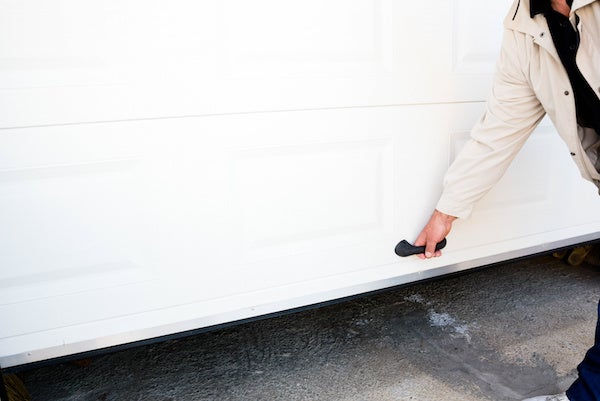
Many American families enjoy a wide array of conveniences such as power tools, televisions, and toasters. Each device, however, has inherent risks. Homeowners take necessary precautions, both indoors and outdoors, to avoid floods, fires, and other mishaps. Home safety should also include the garage. Here are some tips for preventing injuries caused by garage doors.
Safety Mechanisms
Garage door companies aim to minimize the risk of injury to homeowners. One way such businesses achieve this is to offer various safety mechanisms for the garage door. A key safety feature is known as “auto reverse.” This feature means that the door will stop closing (or opening) if it encounters a physical obstacle. Motion detection sensors will cause the door to open if a potential obstacle crosses the path of the garage door. Garage doors should come equipped with a manual release, which allows the homeowner to open and close the door by hand if necessary.
Monthly Inspection
Every month, take inventory of which garage door components seem to need extra attention. Look for rust on any metal parts. Commonly worn areas include the rollers, springs, and cables. A garage door should always run smoothly, even if it is old. Check for unsteady movement or unusual sounds. Wipe clean any very dirty areas, and ensure that metal joints are well-lubricated. If you notice something suspicious, contact a professional for an evaluation. Even if the issue proves minimal, it’s better to err on the side of caution.
Professional Maintenance
Garage door manufacturers recommend that a door be serviced every six months. Doing this will allow potential problems to be corrected before they become a safety issue. The professionals at Thomas V. Giel Garage Doors, Inc. can determine when belts and bolts have become “too worn.” Our experts often check areas where a homeowner may not have considered. Preventative maintenance should only be performed by a professional. The garage door opener is a delicate, powerful system. Avoid mishaps by leaving maintenance and repairs to the experts.
We want our homes and property to be functional, beautiful, and safe. Homeowners vigilantly monitor home security, fire hazards, and other safety concerns. A garage door is generally used several times a day. Like a home entry door, a garage door must be maintained, and repaired when necessary, to maximize safety for the family. The process above will help prevent injuries caused by garage doors.
-
Maintenance to Get Your Garage Door Ready for Cold Weather
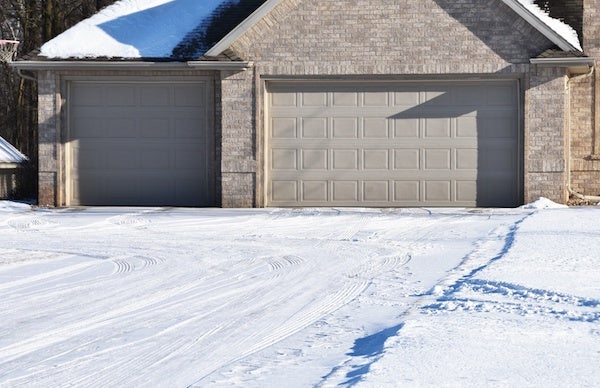
As the weather cools, many homeowners find themselves preparing for winter. Homes are cleaned, and vehicles are serviced. Include the garage door in your home maintenance this year. Below are some ideas for fall maintenance to get your garage door ready for cold weather.
Lubricate
Somewhere in the back of our minds, most of us are aware that garage doors have moving parts and should be lubricated. The reason why doors need lubricant is because moving parts (especially the metal ones) create friction when rubbing together. Increased friction means increased strain on the garage door opener and can lead to mechanical issues. Moving metal parts should be greased every six months with a lubricant designed specially for garage door openers.
Weather Stripping
Weather stripping is a key feature on garage doors. It serves both to protect the garage from drafts and to cushion the door itself. Each year, weather stripping is exposed to harsh conditions such as heat, cold, wind, sun, and rain. Everyday use can also cause wear. Check for areas that are cracked, chipped, or are detached from the door. Repair or replace damaged weather stripping in order to better protect your garage from the elements.
Clean
During the winter, salt and dirt can build up on a garage door, eating away at the finish. Before that can happen, be sure to wash off any existing residue from the garage door. Touch up any areas where the door could use refinishing. Also check the garage door opener and clean any dirty parts, such as the tracks. The onset of winter is also a good time for ensuring the garage itself is clean and organized.
Whether it’s the cooler weather or simply the change of seasons, something motivates people to perform home cleaning and maintenance. Each home feature is important, including the garage door. Avoid costly repairs by maintaining a properly cared-for garage door. Your wallet will thank you. For more helpful information about garage doors, browse the Thomas V. Giel Garage Doors, Inc. blog.
